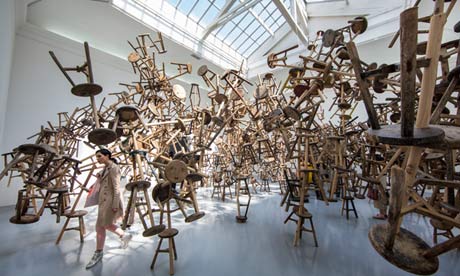Ai Weiwei shows Venice Biennale his many sides
The three large-scale works on display – including horrifying mockups of his 2011 detention – show the artist and activist working confidently in a number of registers
Whatever your views on the Chinese artist Ai Weiwei, one thing is clear: he is everywhere, from the Hampstead theatre in London, where Howard Brenton’s play about the 81 days Ai spent in detention in 2011 is underway, to the web, where his the video for his heavy metal song Dumbass is circulating, to SALT Beyoglu in Istanbul, where you can watch his films from the eighties in New York, to the Venice Biennale, where not one but three of his large-scale works are on display – perhaps the most exposure for any single artist at the international festival.

Waking nightmare … Ai Weiwei’s Entropy (Sleep), from SACRED (2013). Photograph: David Levene
One of the works, Bang, a forest of hundreds of tangled wooden stools, is the most prominent piece in the German national pavilion. Then, in the Zuecca Project Space on the island of Giudecca, is his installation Straight: 150 tons of crushed rebar from schools flattened in the Sichuan earthquake of 2008, recovered by the artist and his team, who bought the crumpled steel rods as scrap before painstakingly straightening them and piling them up in a wave-like sculptural arrangement.
By far the most revealing about Ai’s own experience, though, is the third piece, SACRED. Situated in the church of Sant’Antonin, it consists of six large iron boxes, into which visitors can peek to see sculptures recreating scenes from the artist’s detention. Here is a miniature Ai being interrogated; here a miniature Ai showers or sits on the lavatory while two uniformed guards stand over him. Other scenes show him sleeping and eating – always in the same tiny space, always under double guard. (The music video refers to some of these scenes with a lightly satirical tone that is absent from the sculpture.)
According to Greg Hilty of London’s Lisson Gallery, under whose auspices SACRED is being shown, and who saw Ai in China a week ago, the work is a form of “therapy or exorcism – it was something he had to get out. It is an experience that we might see as newsworthy, but for him, he was the one in it.”
First published by Charlotte Higgins in The Guardian 30.1.2013

